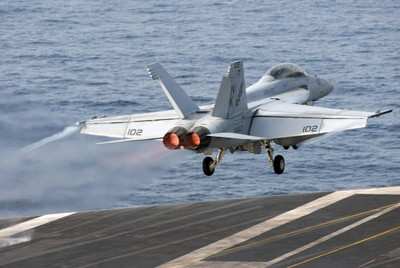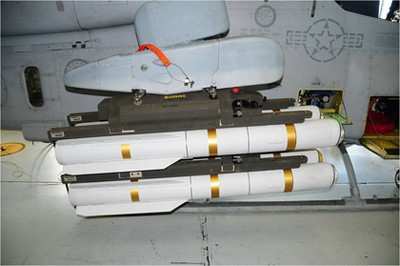Flights Included Refueling, Near Supersonic Speeds
A series of flying quality tests of the U.S. Navy's F/A-18E/F
while carrying the Joint Air-to-Ground Missile (JAGM) was recently
completed at Patuxent River Naval Air Station, MD. Lockheed Martin
conducted a comprehensive series of tests which consisted of six
flights between October 5 and November 2 with a total flying time
of 11.2 hours.

File Photo
The aircraft flew at altitudes ranging from 5,000 feet to 35,000
feet and at speeds approaching Mach 1.0. During each flight, the
Super Hornet was refueled in the air by a support tanker to enable
the aircraft to reach all the required speeds and altitudes at
which JAGM had to be tested.
The JAGM test articles were six instrumented measurement
vehicles (IMVs) equivalent in weight, size and dimensions to
tactical JAGM rounds and outfitted with resistive temperature
devices, acoustic sensors and accelerometers to measure the flight
environments experienced by the launchers and the missiles.
Three IMVs were loaded onto each of two new Navy fixed-wing
triple-rail launchers designed and manufactured by Lockheed Martin
and Marvin Engineering to carry JAGM on the F/A-18E/F. Fully
outfitted, the Super Hornet could be configured to carry 18 JAGMs,
as opposed to just four of the Maverick air-to-ground missiles that
JAGM will replace.
For the flight series, the two "three-packs" of JAGM IMVs were
carried at the most challenging stations -- outboard and midboard
-- in varying load-out combinations with other weapon systems
including bombs, anti-radiation missiles and air-to-air missiles,
as well as external fuel tanks.
"The F/A-18E/F presents some of the most challenging
environments for JAGM," said Hady Mourad, JAGM program director at
Lockheed Martin Missiles and Fire Control. "Collecting vibration,
acoustic and shock data in these environments for 11.2 hours of
flight with no anomalies or problems represents a very successful
beginning of flight test efforts that will continue into the EMD
phase to integrate JAGM on the Super Hornet."
Lockheed Martin's Deputy Program Director Rick Packard, who is
responsible for integrating JAGM with Navy platforms, said the
company was very pleased with the results of the flying qualities
tests. "When you couple the highly successful outcome of these
flying quality tests with our previous hot and cold temperature
missile motor tests, we remain confident in our ability to provide
our customers with a single-missile-motor offering for JAGM, a
critical capability voiced by all three Services since the
inception of the joint program."

JAGM Ordinance Lockheed Martin Photo
"One of the key tenets of the JAGM program is to replace three
aging weapon systems and their associated parts, supply and
logistics networks with one weapon to increase operational
flexibility and reduce support costs," Packard said. "We remain
steadfastly committed to meeting that requirement."
Threshold aviation platforms include the U.S. Army's AH-64D
Apache attack helicopter, the Army's Extended Range Multi-Purpose
(ERMP) Sky Warrior unmanned aerial system, the U.S. Marine Corps'
AH-1Z Super Cobra attack helicopter, the U.S. Navy's MH-60R Seahawk
armed reconnaissance helicopter and the Navy's F/A-18E/F Super
Hornet jet fighter. The tri-service Joint Strike Fighter also is
under consideration as an objective platform.
The initial operational capability of JAGM on the AH-64D, AH-1Z
and F/A-18E/F is scheduled for 2016, and the IOC for the MH-60R and
ERMP is 2017.
 NTSB Prelim: Lee Aviation LLC JA30 SuperStol
NTSB Prelim: Lee Aviation LLC JA30 SuperStol Classic Aero-TV: Curtiss Jenny Build Wows AirVenture Crowds
Classic Aero-TV: Curtiss Jenny Build Wows AirVenture Crowds ANN's Daily Aero-Term (05.30.25): Very High Frequency (VHF)
ANN's Daily Aero-Term (05.30.25): Very High Frequency (VHF) Aero-News: Quote of the Day (05.30.25)
Aero-News: Quote of the Day (05.30.25) Classic Aero-TV: Quest Kodiak Enhances Migration Monitoring Programs
Classic Aero-TV: Quest Kodiak Enhances Migration Monitoring Programs




